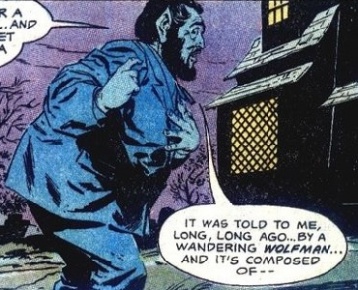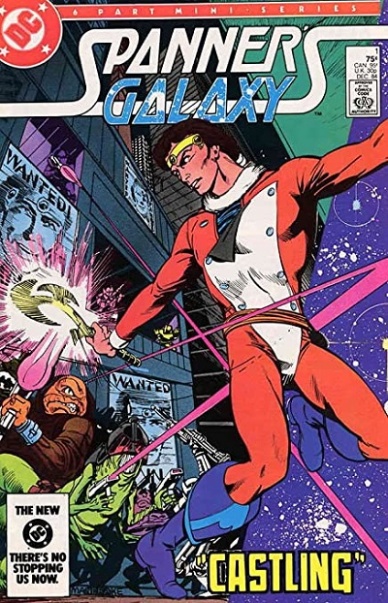Multiversity’s history column returns with a smorgasbord of items from comic history related to December. Please consider this recap of dead guys, monstrous credits, printing developments, and last shipping books my gift to you.

Before comic books existed, cartoonists were developing their skills and technical conventions in newspaper strips. Many of their innovations are so obvious, a modern reader might be surprised to learn that someone had to invent things like panel borders, variations in panel sizes, and inset panels. There was also constant innovation in content, as new things were tried constantly.
On December 4, 1925, the one-panel gag cartoon “Out Our Way,” carried an unheralded, inevitable first when it depicted a corpse. Considering how long newspaper comics had been around, you have to wonder why it took so long. Was it creator discretion? Syndicate censorship? Fear of backlash? Good taste? Whatever it was, it was unfounded because as far I can find, there were no complaints about illustrated dead bodies. Certainly none that made any difference.

Even in the late sixties, there were comics from established publishers that weren’t carrying creator credits. That meant that the writer and artist for any of DC’s mystery comics remained, ironically, a mystery. That was unintentionally changed in December 1969.
“The House of Secrets” was an anthology book with a Crypt Keeper-like host who appeared at the beginning and end of each story. In issue 83, editor Gerry Conway had the host introduce one story as “told […] by a wandering wolfman.” This caught the attention of its CCA reviewer because the mere mention of werewolves violated the Comics Code, even though the story had nothing else to do with werewolves. By that time, the deadline for getting the book to the printer was near if not passed, so DC solved the problem in the quickest way possible.
Conway hadn’t just pulled that line from thin air, you see. He was inspired by the writer’s name – Marv Wolfman. Therefore, the easiest way to get past the censor was to slap on a writer credit that made the pun obvious to everyone. It worked – the book carried the CCA seal – but everyone at DC knew about it. Within two months, every story in the anthology was being credited to the writer and penciler. Credits were one step closer to being universal.

Since 1948, nearly all American comic books had been printed in one place: the World Color Press factory in Sparta, Illinois. By 1980, its letterpress machines were both wearing out and becoming obsolete. While WCP debated the merits of repair vs replacement, Marvel and DC began experimenting with offset printing with Canada-based Ronald’s Printing.
Offset printing was more expensive to begin with, and producing it in Canada added other costs. However, it was also undeniably higher quality. Not only could it reliably reproduce thinner lines, it also allowed artwork to extend to the edge of the page (a “full bleed”). This freed artists from the constraint of leaving a gutter between two panels, which opened up the page to more interesting layouts. The catch was that the potential quality of offset printing exceeded the limits of the traditional newsprint paper stock on which comics were printed. That meant better paper stock was needed, and that meant yet another additional cost.
To compensate for the extra spending, Marvel and DC had to charge more per issue. To limit the impact, and to give themselves more time to experiment with the best production combinations, both companies limited offset printing to special projects. Marvel’s first attempt was “Marvel Fanfare” in March 1982 on glossy magazine stock. DC tried Baxter paper stock with its release of “Camelot 3000” in December 1982.
“Camelot 3000” was a first in a lot of ways. It was the first “maxi-series,” a term created for the 12-issue story when “mini-series” felt too small. It was DC’s first book intended for mature readers, paving the way for “Dark Knight Returns” and “Watchmen.” It wasn’t the first book with Baxter paper (it was beat by “Star*Reach” in 1979 and “Star Wars” in 1980), but it was the first to combine the heavy paper stock with offset printing. The results were great.
Continued belowDC was so pleased with the results that in 1984, they began offering deluxe editions of “Legion of Super-Heroes”, “New Teen Titans”, and “Outsiders” in the format. The deluxe editions were exclusive to the direct market, with newsstands receiving the traditional format versions a year later. The higher cost and limited distribution allowed the creators to assume an older readership and work accordingly (but still within the CCA guidelines).
Pacific Comics, a regional distributor, labeled these as “Baxter Books” in their catalog so retailers would know what they were getting. No one else had a name for them, so “Baxter Books” stuck. In the years going forward, DC would use the paper stock in its promotional material as a selling point to emphasis the quality of a title.

World Color Press’s equipment continued to deteriorate, and it became clear that even with regular maintenance, their letterpress would not survive past 1986. To keep costs low, their first attempt at an upgrade was a move to flexograph equipment. The name came from the use of rubber printing plates in place of metal ones.
DC’s first flexograph book was “Spanner’s Galaxy” #1, cover dated December 1984. The quality was obviously lower that letterpress, and Marvel delayed switching until late in 1985, when their other choice was a shutdown. The flexograph method produced garish color with low density blacks, and it took a year and a half of experimentation from both companies to figure out the best combination of paper and color saturation. They bounced back and forth between newsprint and Mando paper stock, as both had weaknesses and the one they didn’t use always seemed like it would work better.
As offset printing became cheaper, more books switched to that. Flexograph was phased out for good around 1992.

Since the formation of Image Comics early in the year, every book they released was hot seller. As each founder released their own book, speculators and countless young fans ate them up. Liefeld on “Youngblood.” McFarlane on “Spawn.” Larsen on “Savage Dragon.” Lee on “WildCATS.” Valentino on “Shadowhawk.” Silvestri on “Cyber Force.” The industry was booming, and retailers everywhere were happy to order high on anything with that funky i in the corner when final founder, Whilce Portacio, scheduled “WetWorks” #1 for December 1992.
When the two national distributors, Diamond and Capital City, released their sales charts for December, “WetWorks” was ranked fifth. That didn’t surprise anyone – aside from the standard Image hype, the series had been featured on the cover of the November issue of “Wizard,” which had just begun to show its power. There was just one problem – “WetWorks” #1 didn’t actually ship. No stores had it. No readers bought it. This best-selling book hadn’t been sold.
Portacio became the butt of a lot of jokes, and “WetWorks” was briefly a punchline. Those dried up when readers learned that Portacio wasn’t lazy or irresponsible, his sister was dying. Not only that, she helped run his studio, so he was grieving and short a person at work.
Besides, the real impact of “WetWorks” wasn’t Portacio’s fault, nor was it limited to just him. Image as a whole was gaining a reputation for lateness. The big problem was that the direct market had been built on prepayments. All those copies of “WetWorks” that retailers didn’t sell? They still had to pay for them. An inconvenience that was manageable when a low-selling book was a month late became a major financial issue when a top seller never arrived. Without an easy way to recoup their investment, retailers found themselves short on cash and unable to order replacement inventory for the next month.
Image’s problems rippled through the industry and weakened its foundation prior to the big bust in 1993. Some corrections were made relatively quickly, like Capital City imposing fines on late books in 1994. It wasn’t until February 2003 that Diamond finally switching from reporting the number of books ordered to the number of books shipped. That change meant late books would never appear on a sales list unless they had actually sold.
And “WetWorks?” The first issue eventually shipped in June 1994.






